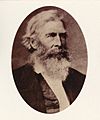Henry W. Miller facts for kids
Henry William Miller (born May 1, 1807 – died October 9, 1885) was an important early leader in Iowa. He was the very first person to represent the area of Council Bluffs, Iowa in the Iowa legislature.
Contents
Early Life and Moving West
Henry William Miller was born in Lexington, Greene County, New York. When he was young, he learned the skill of carpentry. Around 1828, he moved to Illinois and settled in a town called Quincy, Illinois.
A New Faith
In September 1839, Henry Miller became a member of The Church of Jesus Christ of Latter-day Saints (often called the LDS Church). He became a leader, serving as the president of the Freedom Stake of the church. This meant he was in charge of the Church's activities in Adams County, Illinois. This leadership role lasted from October 1840 to May 1841.
Around 1841, he moved to Nauvoo, Illinois. This was a major gathering place for members of the LDS Church at the time. Miller was chosen to be part of the committee that helped build the Nauvoo Temple. He was even sent to lumber mills in Wisconsin to help get wood for the temple. After most Church members left Nauvoo, Miller returned. He was one of the people responsible for selling the land the Church owned there.
A Leader in Iowa
After the members of the LDS Church left Nauvoo, Henry Miller settled on the east side of the Missouri River. This place was first called Miller's Hollow, named after him! Later, it was renamed Kanesville, and today it is known as Council Bluffs, Iowa. In 1851, Miller was elected to the Iowa legislature from Pottawattamie County.
Moving to Utah
In 1852, Miller traveled to Utah Territory. He led a group of Mormon pioneers as their captain. These pioneers were people who moved west to settle new areas. Miller continued his public service in Utah. He was a member of the Utah Territorial Legislature from 1852 to 1854.
Helping Others
From 1855 to 1857, Miller served as a missionary for the LDS Church among the Cherokee people. He taught and baptized many Cherokee individuals. He also helped many people who had followed another leader named Lyman Wight in that same area. On his way back, he traveled through Missouri. There, he helped another Church leader, Erastus Snow, get cattle for the journey west.
Later Life
In 1864, Henry Miller led a group of Church members to start a new settlement. They called it Millersburg. Today, this place is known as Beaver Dam, Arizona. However, Millersburg was flooded in 1866. After that, Miller lived in St. George, Utah for most of the rest of his life. He passed away while visiting his brother in Farmington, Utah.
Images for kids


